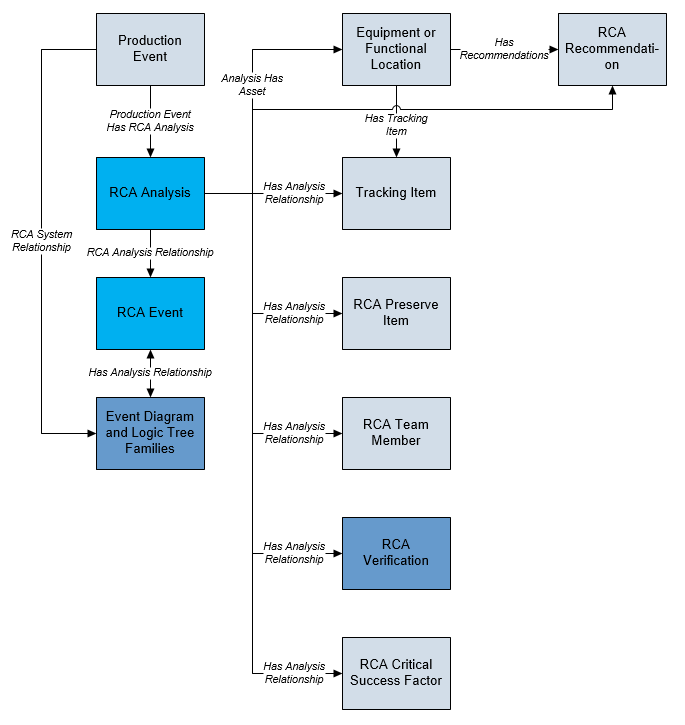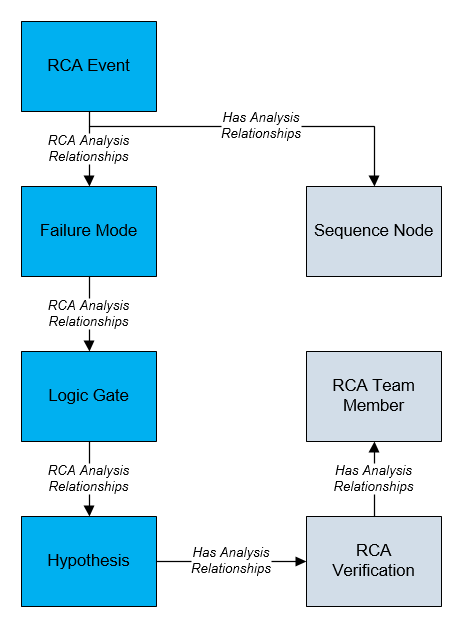RCA Template Data Loader
About the Root Cause Analysis (RCA) Template Data Loader
- Legacy analysis templates
- Update existing RCA Analyses that have been exported from APM
The data loader transfers data from a fixed-format Excel workbook into either the RCA Data Model or the RCA Logic Tree. The imported data can be any of the following records:
- An RCA Analysis Template
- An RCA Event
- A Failure Mode
- A Logic Gate
- An RCA Hypothesis
- An RCA Diagram RelationshipNote: The Root Cause Analysis (RCA) Data Loader is not backward compatible with earlier versions of APM.
The RCA Data Loader Template Requirements
To use the Root Cause Analysis (RCA) Template Data Loader, your organization must have completed the deployment of the Root Cause Analysis module.
Security Settings
The Security User performing the data load operation must be associated with either the MI Data Loader User or MI Data Loader Admin Security Role, and must also be associated with the MI PROACT Administrator Security Group or a Security Role that is associated with this Security Group.
The RCA Data Loader Data Models
RCA Data Model

RCA Logic Tree Data Model

The RCA Template Data Loader General Loading Strategy
Best Practices
- ID fields (row 2 of each worksheet) must not include special characters or spaces.
- Columns in the worksheets must be formatted as either text or dates.
- The first two rows of each worksheet must not be modified.
- Only import a maximum of 500 analyses in each data load.
- You must use the Root Cause Analysis (RCA) Data Loader workbook (Root Cause Analysis (RCA).xlsx). Do not change the values in column headings in any of the worksheets.
Limitations
- Any column values in a customized format will not be imported by the data loader.
- If you import the same data multiple times, the most recently imported data is included in the database. If a record is already available in the database and is then reimported, the newly imported file will replace the existing file in the database. The Root Cause Analysis (RCA) Data Loader does not append to the existing record.
Load Sequence
- An RCA Analysis is created.
- RCA Events are created and linked to the RCA Analysis through the RCA Analysis Relationship.
- Failure Modes are created and linked to the RCA Event through the RCA Analysis Relationship.
- Logic Gates are created and linked to a Failure Mode through the Has Analysis Relationship, where the Failure Mode is the predecessor of the Logic Gate.
- Hypotheses are created and linked to a Logic Gate through the Has Analysis Relationship, where the Hypothesis is the successor of the Logic Gate.
The RCA Template Data Loader Workbook Layout and Use
To import data using the data loader, we provide an Excel workbook (Root Cause Analysis (RCA).xlsx) that supports baseline Root Cause Analysis in APM. This template must be used to perform the data load. Using custom changes in code and in design, you can modify the Excel template to include custom fields used by your organization.
| Worksheet | Description |
|---|---|
| RCA_Analysis_Template | This worksheet is used to define Analysis records. |
| RCA_Event | This worksheet is used to define Event records. |
| RCA_Failure_Mode | This worksheet is used to specify Failure Mode details. |
| RCA_Logic_Gate | This worksheet is used to specify Logic Gate details. |
| RCA_Hypothesis | This worksheet is used to specify Hypothesis details. |
| RCA_Diagram_Relationship | This worksheet is used to specify Diagram Relationship details. |
| RCA_SecondaryEvent | This worksheet is used to specify Secondary Event details. |
RCA Diagram Relationship
The following Logic Tree diagram shows an RCA Diagram Relationship for a Pump Failure. The Logic Tree displays two distinct parent nodes and their subsequent child nodes:
| RCA Template Key | Parent Node Key | Child Node Key | Parent Node Type | Child Node Type |
|---|---|---|---|---|
| RCA_TEMPLATE_KEY | PARENT_NODE_KEY | CHILD_NODE_KEY | PARENT_NODE_TYPE | CHILD_NODE_TYPE |
| 1234 | None | 101 | RCA_Analysis_Template | RCA_Event |
| 1234 | 101 | 201 | RCA_Event | RCA_Failure_Mode |
| 1234 | 101 | 202 | RCA_Event | RCA_Failure_Mode |
| 1234 | 201 | 301 | RCA_Failure_Mode | RCA_Logic_Gate |
| 1234 | 202 | 302 | RCA_Failure_Mode | RCA_Logic_Gate |
| 1234 | 301 | 401 | RCA_Logic_Gate | RCA_Hypothesis |
| 1234 | 301 | 402 | RCA_Logic_Gate | RCA_Hypothesis |
| 1234 | 302 | 403 | RCA_Logic_Gate | RCA_Hypothesis |
System Code Tables
| Field Name | Field ID |
|---|---|
| Analysis Type | MI_AN_ANALY_TYPE_CHR |
| Hypothesis Confidence Factors | MI_RCA_HYPOTHESIS_CONFIDENCE_FACTORS |
| Hypothesis State | RCA_Hypothesis_State |
RCA_Analysis_Template Worksheet
| Field Caption | Field ID | Data Type (Length) | Comments |
|---|---|---|---|
| Analysis Description | MI_AN_SHORT_DESCR_CHR | Character (255) | None |
| Analysis ID | MI_AN_ANALY_ID_CHR | Character (255) | A value is required and must be unique. |
| Analysis Type | MI_AN_ANALY_TYPE_CHR | Character (50) | Enter one of the following values:
|
| Comments | MI_RCA_ANALY_COMME_TX | Text | None |
| Cost Number | MI_RCA_ANALY_COST_NBR | Numeric | The estimated cost of the failure events you are analyzing. By default, the currency is set to $. |
| End Date | MI_RCA_ANALY_END_DATE_DT | Date | Enter a value in the following format based on your local time zone: YYYY-MM-DD HH:mm:ss (for example, 2015-01-31 17:30:00). The date specified in the End Date field must be greater than the date specified in the Start Date field. |
| Event Narration | MI_RCA_ANALY_EVENT_NARRA_TX | Text | Information about the equipment failure |
| Frequency Number | MI_RCA_ANALY_FREQU_NBR | Numeric | None |
| RCA Analysis Key | RCA_ANALYSIS_KEY | Numeric | A value is required and must be unique. |
| Start date | MI_RCA_ANALY_START_DATE_DT | Date | Enter a value in the following format dependent on your local time zone: YYYY-MM-DD HH:mm:ss (for example, 2015-01-31 17:30:00). |
RCA Event Worksheet
| Field Caption | Field ID | Data Type (Length) | Comments |
|---|---|---|---|
| Event End Date | MI_EVENT_END_DT | Date | If the Root Cause Analysis was created from a Production Event, this field will be populated automatically with the value in the End Date field of that Production Event. Otherwise, you can define this value manually when you create the RCA Event. The date specified in the End Date field must be greater than the date specified in the Start Date field. |
| Event Label | MI_RCA_EVENT_LABEL_CHR | Character (255) | If the RCA was created from a Production Event, this field will be populated automatically with the value in the Headline field of that Production Event. Otherwise, you can define this value manually when you create the RCA Event. This field is required. |
| Event Long Description | MI_EVENT_LNG_DSC_TX | Text | If the RCA was created from a Production Event, this field will be populated automatically with the value in the Description field of that Production Event. Otherwise, you can define this value manually when you create the RCA Event. |
| Event Start Date | MI_EVENT_STRT_DT | Date | If the RCA was created from a Production Event, this field will be populated automatically with the value in the Start Date field of that Production Event. Otherwise, you can define this value manually when you create the RCA Event. |
| Event X Position Number | MI_RCA_EVENT_XPOSI_NBR | Numeric | The RCA Event Node is placed in the diagram at a predefined position, where the X Position Number is 350. A different value can be entered, but 350 is recommended. |
| Event Y Position Number | MI_RCA_EVENT_YPOSI_NBR | Numeric | The RCA Event Node is placed in the diagram at a predefined position, where the Y Position Number is 30. A different value can be entered, but 30 is recommended. |
| RCA Event Key | RCA_EVENT_KEY | Numeric | This field is required and must be unique. |
| RCA Template Key | RCA_TEMPLATE_KEY | Numeric | This field is required and must match the template key provided in the RCA_Analysis_Template worksheet. |
RCA Failure Mode Worksheet
| Field Caption | Field ID | Data Type (Length) | Comments |
|---|---|---|---|
| Failure Mode Description | MI_RCA_FAILU_MODE_DESCR_TX | Text | The value of this field is a detailed description of the failure mode. |
| Failure Mode Label | MI_RCA_FAILU_MODE_LABEL_CHR | Character (255) | The name of the failure mode that you want to appear on the Logic Tree. |
| RCA Failure Mode Key | RCA_FAILU_MODE_KEY | Numeric | This field must contain a unique value that identifies a RCA Failure Mode. This field is required. |
| RCA Template Key | RCA_TEMPLATE_KEY | Numeric | This field is required and must match the template key provided in the RCA_Analysis_Template worksheet. |
RCA Logic Gate Worksheet
| Field Caption | Field ID | Data Type (Length) | Comments |
|---|---|---|---|
| Logic Gate Type | MI_RCA_LOGIC_GATE_GATE_TYPE_CH | Character (50) | Enter one of the following values:
|
| Long Description | MI_RCA_LOGIC_GATE_LONG_DESCR_T | Text | The value of this field is a detailed description of the logic gate. |
| RCA Logic Gate Key | RCA_LOGICGATE_KEY | Numeric | This field is required and must be unique. |
| RCA Template Key | RCA_TEMPLATE_KEY | Numeric | This field is required and must match the template key provided in the RCA_Analysis_Template worksheet. |
| Short Description | MI_RCA_LOGIC_GATE_SHORT_DESCR_CHR | Character (255) | None |
RCA Hypothesis Worksheet
| Field Caption | Field ID | Data Type (Length) | Comments |
|---|---|---|---|
| Confidence Factor Number | MI_RCA_HYPOT_CONFI_FACTO_NBR | Numeric | Enter one of the following values:
|
| Description | MI_RCA_HYPOT_DESCR_TX | Text | The value of this field is a detailed description of the hypothesis. |
| Hypothesis State | MI_RCA_HYPOT_STATE_CHR | Character (255) | You can choose from the following states:
|
| Label | MI_RCA_HYPOT_LABEL_CHR | Character (255) | The value of this field is a description of the hypothesis as you want it to appear on the Logic Tree. |
| RCA Hypothesis Key | RCA_HYPOTHESIS_KEY | Numeric | This field is required and must be unique. |
| RCA Template Key | RCA_TEMPLATE_KEY | Numeric | This field is required and must match the template key provided in the RCA_Analysis_Template worksheet. |
RCA Diagram Relationship Worksheet
| Field Caption | Field ID | Data Type (Length) | Comments |
|---|---|---|---|
| RCA Template Key | RCA_TEMPLATE_KEY | Numeric | This field is required and must match the template key provided in the RCA_Analysis_Template worksheet. |
| Parent Node Key | PARENT_NODE_KEY | Numeric | The value of this field is the node key of the parent node. The parent node key is blank only when the parent-child relationship is created by an RCA Event. |
| Child Node Key | CHILD_NODE_KEY | Numeric | This field is required and must be unique. |
| Parent Node Type | PARENT_NODE_TYPE | Character (50) | This field is required. |
| Child Node Type | CHILD_NODE_TYPE | Character (50) | This field is required. |
About the RCA Data Loader Load Verification
After a successful data load, you can navigate to the RCA Overview page and view any of the imported workbooks to view the details and logic tree associated with the workbook and to import workbook content into an analysis.
A successful import can also be defined as an event where partial data on a worksheet is loaded into APM, and where you provide appropriate messaging that enables you to identify and correct issues resulting from the import.